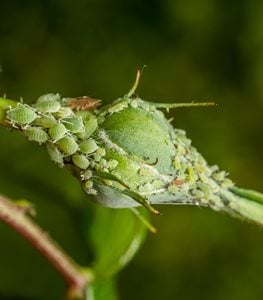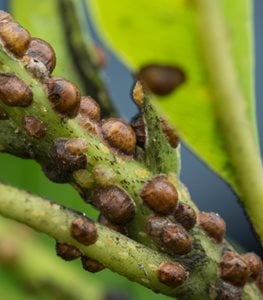7 Houseplant Pests: How to Identify & Treat Them
How to get rid of bugs on indoor plantsHouseplants are a great way to bring the great outdoors in and enhance your home. However, with great greenery comes great responsibility—and this time we are talking about pest control. Here are a few of the most common houseplant pests and how to remedy them should you discover an infestation.
See also: Houseplant Care: 12 Tips for Healthy Indoor Plants
COMMON HOUSEPLANT BUGS
APHIDS
Aphids are small pear-shaped pests and can be a variety of colors, including green, yellow, brown, black, or even pink.
Aphids will typically be found feasting on the undersides of leaves or new growth. These sap-sucking pests will cause foliage to yellow and deform. The presence of aphids can also be determined by shiny or sticky areas on leaves.
Aphid control involves hand-wiping, water spraying, or using swabs dipped in 70% alcohol to remove the pests from the plant. Treatment may require multiple attempts and insecticidal soap spray may help reduce the number of times aphids will reappear.
Read more about how to treat aphids.
FUNGUS GNATS
Fungus gnats are often mistaken as mosquitoes as they fly around the home. However, these weak fliers are easier to clap-away than most other flying bugs.
Fungus gnats are typically not a threat to the health of houseplants but are certainly annoying to have in the home. However, their larvae feed off of decaying organic matter and can be found in moist soil. Uncommon, but possible heavy infestations can negatively affect your plant as larvae can feed on the plant’s root system.
Controlling fungus gnats can be as simple and changing your potting mix. Dense overwatered soil is the perfect breeding ground and using a well-draining potting mix can deter adult fungus gnats from setting up shop and even kill the larvae.
Read more about how to treat and prevent fungus gnats.
LEAF MINERS
Leafminers are rarely seen themselves, as their presence is determined by irregular trails or blotches found on leaves. Leafminers are not a specific bug, but the larvae of a variety of insects and feed between the upper and lower surfaces of foliage. Aside from being visually unappealing, the damage caused by leafminers are not as serious as other pests.
Leafminer control involves removing damaged leaves that display leafminer damage. Insecticidal sprays may also be used to deter the pests from being abel to enter the leaves.
MEALYBUGS
Mealybugs are small white, almost fluffy looking pests that can be found on the lower surfaces of plants but can be found all over the plant when heavily infested. Some mealy bugs are also found in the soil, feeding on root systems. These cotton-looking pests feed on sap and their damage can cause stunted or deformed growth.
Controlling mealybugs can be as simple as hand-wiping them away with cotton swabs dipped in 70% alcohol and sprayed with insecticidal soap. However, heavily infested plants may be better off discarded.
Learn more about controlling mealybugs.
SCALE
Scale are either soft or hard body (armored) pests. Scale appear to be flat round or oblong growths usually found on stems and undersides of leaves. These legless busts are usually identifiable by their dark spot in the center of their lighter colored body. These pests, like most, feed off plants for their sap.
Scale control is most effective in the early stages of an infestation and can be scraped off with your fingernail. They can also be defeated using insecticides including neem and canola oils.
Learn more about controlling scale.
SPIDER MITES
One of the most dreaded pests are spider mites. These pests are extremely small and difficult to be seen with the naked eye, but their presence is usually identified by the silky webs they leave among leaves and stems.
These tiny invasive pests can cause a lot of damage, very quickly resulting in faded coloring among the foliage. Plants notorious for suffering from spider mite infestations include alocasias, palms, and English ivy.
Spider mite control is intensive compared to other pests. An infested plant should be thoroughly sprayed to dislodge the bugs and destroy their webs. Insecticidal soap, neem oil, or insecticides containing sulfur are a popular option in treating infested plants. Completely ridding the plant of spider mites usually takes several consecutive weeks of treatment.
Learn more about controlling spider mites.
THRIPS
Thrips are fast-moving small, long, and thin pests with fringed wings. They are often found on the tops of leaves, feeding off sap. Thrip damage is noticeable as foliage can fade, brown, or die off completely.
Controlling thrips involves rinsing off the plant and then spraying it with insecticidal soap. Many plant parents will use sprays with Spinosad as an active ingredient. However, Spinosad kills both beneficial and harmful pests. So, if you release ladybugs, praying mantises, or any other beneficial pest, Spinosad should not be used.
Learn more about how to control thrips.
HELP WITH PEST PREVENTION
Pest prevention is often thought of as weekly applications of natural and/or chemical pest deterrents. However, the most basic step is often overlooked: potting mix. Well-draining potting mixes are a great soil option for overall plant health.
A secondary line of defense that can be added to help deter pests is pebble ground cover. Pebbles should only be used with well-draining potting mixes, as they are known to trap moisture when used with dense soil.
RELATED:
21 Best Indoor Plants
Growing Pothos
Bringing Plants Inside for Winter










